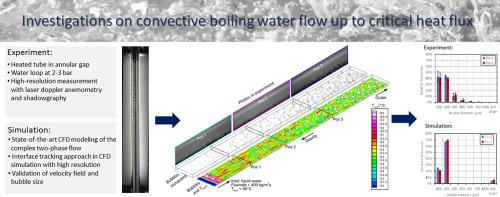当前位置:
X-MOL 学术
›
Int. J. Multiphase Flow
›
论文详情
Our official English website, www.x-mol.net, welcomes your feedback! (Note: you will need to create a separate account there.)
Subcooled forced convection boiling flow measured using high-resolution techniques at the COSMOS-L facility and accompanying CFD simulation employing an interface-tracking scheme
International Journal of Multiphase Flow ( IF 3.8 ) Pub Date : 2024-02-24 , DOI: 10.1016/j.ijmultiphaseflow.2024.104772 Florian Kaiser , Yohei Sato , Stephan Gabriel
International Journal of Multiphase Flow ( IF 3.8 ) Pub Date : 2024-02-24 , DOI: 10.1016/j.ijmultiphaseflow.2024.104772 Florian Kaiser , Yohei Sato , Stephan Gabriel

|
This paper describes state-of-the-art experimental measurement techniques and computational fluid dynamics methods applied to subcooled forced convection boiling flow at 2-3 , both featuring high spatial- and time-resolution measurements. The objectives are: (i) to provide the measured boiling flow data, e.g. average and RMS profiles of axial and radial velocities and bubble size distributions, and (ii) to evaluate the capabilities of state-of-the-art numerical simulation techniques to model the observed phenomena, by comparison between measured data and numerical prediction. In the experiment, the bubble velocities in the axial and radial directions were measured using laser Doppler anemometry, and the bubble size was estimated by a shadowgraphy method. The simulation results, incorporating an interface capturing technique, showed good agreement with measurement in terms of the wall temperature and axial velocity, but underestimation of the radial velocity, and overestimation of bubble sizes. The paper shows that the discrepancies between measurement and simulation may be traced to: (i) the uncertainties in the nucleation site density model; (ii) too coarse a grid being adopted, which is not able to resolve the thermal boundary layer around the bubbles; and (iii) spurious numerical bubble coalescence, a feature not seen in the experiment. The mechanism of bubble lift-off from the hot surface, without any sliding motion, as observed in the experiment, is discussed in detail, based on the simulation results, and the condensation on the bubble cap as the bubble is ‘sucked’ into the bulk flow is also examined.
中文翻译:

在 COSMOS-L 设施中使用高分辨率技术测量过冷强制对流沸腾流,并使用界面跟踪方案进行 CFD 模拟
本文介绍了应用于 2-3 度过冷强制对流沸腾流的最先进的实验测量技术和计算流体动力学方法,两者都具有高空间和时间分辨率测量功能。目标是:(i) 提供测量的沸腾流数据,例如轴向和径向速度的平均值和 RMS 分布以及气泡尺寸分布,以及 (ii) 评估最先进的数值模拟技术的能力通过比较测量数据和数值预测来对观察到的现象进行建模。实验中,利用激光多普勒风速仪测量了气泡在轴向和径向的速度,并通过阴影成像方法估计了气泡尺寸。结合了界面捕捉技术的模拟结果显示,壁温和轴向速度与测量结果非常吻合,但低估了径向速度,高估了气泡尺寸。该论文表明,测量与模拟之间的差异可能归因于:(i)成核位点密度模型的不确定性; (ii) 采用的网格太粗,无法解析气泡周围的热边界层; (iii) 虚假数值气泡合并,这是实验中未发现的特征。基于模拟结果,详细讨论了实验中观察到的气泡从热表面升离的机制,没有任何滑动运动,以及当气泡被“吸入”到气泡中时气泡帽上的凝结。还检查了总体流量。
更新日期:2024-02-24
中文翻译:

在 COSMOS-L 设施中使用高分辨率技术测量过冷强制对流沸腾流,并使用界面跟踪方案进行 CFD 模拟
本文介绍了应用于 2-3 度过冷强制对流沸腾流的最先进的实验测量技术和计算流体动力学方法,两者都具有高空间和时间分辨率测量功能。目标是:(i) 提供测量的沸腾流数据,例如轴向和径向速度的平均值和 RMS 分布以及气泡尺寸分布,以及 (ii) 评估最先进的数值模拟技术的能力通过比较测量数据和数值预测来对观察到的现象进行建模。实验中,利用激光多普勒风速仪测量了气泡在轴向和径向的速度,并通过阴影成像方法估计了气泡尺寸。结合了界面捕捉技术的模拟结果显示,壁温和轴向速度与测量结果非常吻合,但低估了径向速度,高估了气泡尺寸。该论文表明,测量与模拟之间的差异可能归因于:(i)成核位点密度模型的不确定性; (ii) 采用的网格太粗,无法解析气泡周围的热边界层; (iii) 虚假数值气泡合并,这是实验中未发现的特征。基于模拟结果,详细讨论了实验中观察到的气泡从热表面升离的机制,没有任何滑动运动,以及当气泡被“吸入”到气泡中时气泡帽上的凝结。还检查了总体流量。



























 京公网安备 11010802027423号
京公网安备 11010802027423号